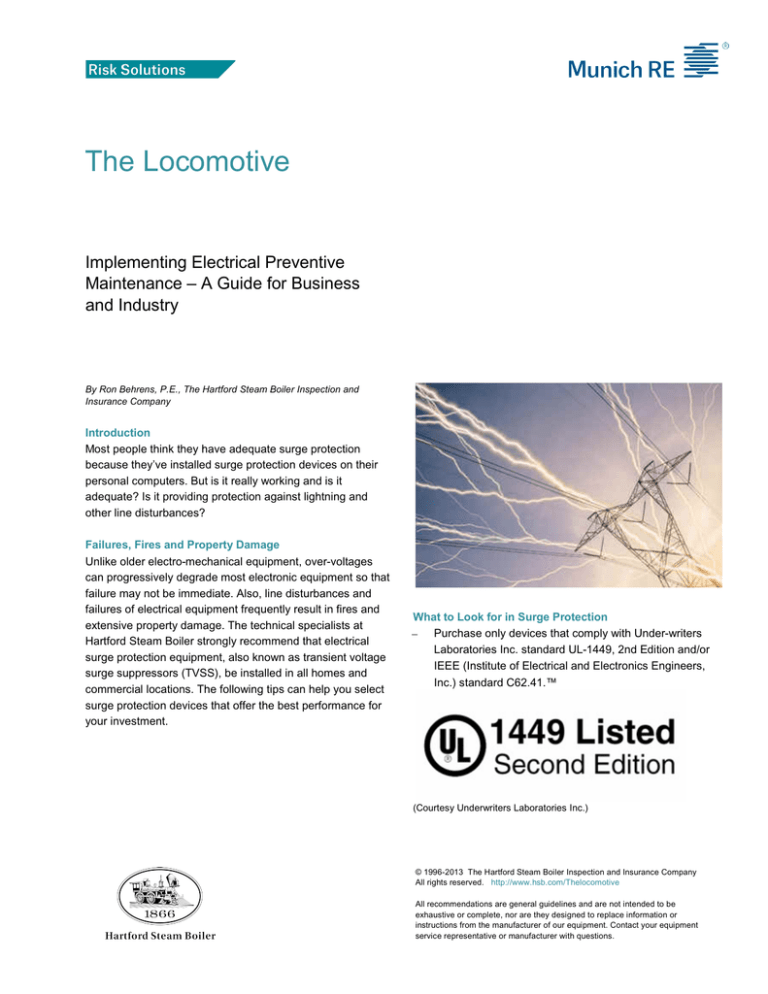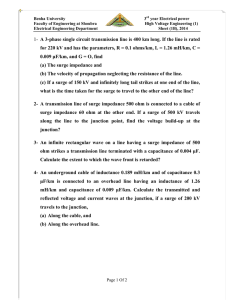
The Locomotive
Implementing Electrical Preventive
Maintenance – A Guide for Business
and Industry
By Ron Behrens, P.E., The Hartford Steam Boiler Inspection and
Insurance Company
Introduction
Most people think they have adequate surge protection
because they’ve installed surge protection devices on their
personal computers. But is it really working and is it
adequate? Is it providing protection against lightning and
other line disturbances?
Failures, Fires and Property Damage
Unlike older electro-mechanical equipment, over-voltages
can progressively degrade most electronic equipment so that
failure may not be immediate. Also, line disturbances and
failures of electrical equipment frequently result in fires and
extensive property damage. The technical specialists at
Hartford Steam Boiler strongly recommend that electrical
surge protection equipment, also known as transient voltage
surge suppressors (TVSS), be installed in all homes and
commercial locations. The following tips can help you select
surge protection devices that offer the best performance for
your investment.
What to Look for in Surge Protection
− Purchase only devices that comply with Under-writers
Laboratories Inc. standard UL-1449, 2nd Edition and/or
IEEE (Institute of Electrical and Electronics Engineers,
Inc.) standard C62.41.™
(Courtesy Underwriters Laboratories Inc.)
© 1996-2013 The Hartford Steam Boiler Inspection and Insurance Company
All rights reserved. http://www.hsb.com/Thelocomotive
All recommendations are general guidelines and are not intended to be
exhaustive or complete, nor are they designed to replace information or
instructions from the manufacturer of our equipment. Contact your equipment
service representative or manufacturer with questions.
The Hartford Steam Boiler
Inspection and Insurance Company
The Locomotive
Page 2
−
Surge suppression equipment should have a visual
indication on the device indicating protector status; or
as an alternative, have electrical contacts on the surge
protection device for remote monitoring.
−
−
−
Indicators of Protection Status (Courtesy TEGG Corp.)
−
The manufacturer should provide an extended warranty
or guarantee and this should not contain any exclusions
for lightning.
Installing Surge Protection
− Power surges can originate from outside and inside a
building. The best way to protect your electrical
equipment is with zones of protection.
1. The first level of defense is surge protection on the
main electrical equipment where the utility power
comes into the building. This protects against high
energy external surges such as lightning or utility
transients.
2. The second zone of protection is at circuit breaker
panels and distribution panels within a facility.
3. The third zone of protection is “point-of-use” surge
protection devices for specific or nearby groups of
equipment such as computers and computercontrolled equipment. Zone 2 and 3 devices protect
against both internally and externally generated
surges. Commercial locations should have at least
−
−
two zones of protection: electrical service entrance
and point-of-use.
Surge suppression devices that are connected to the
building’s main electrical entrance require a large
conductor. This conductor must meet the device
manufacturer’s specifications, and should be as short
and straight as possible. Lengths of this conductor
greater than 18 inches will allow a higher than designed
voltage surge to get through, which is undesirable.
It is critical that your home or facility be connected to a
good, low-resistance ground. A surge protection device
is designed to divert surge current to ground and bypass
your equipment. Without a proper grounding system,
there is very little that can be done to protect against
surges. Testing may be needed to verify a lowresistance ground.
Surge protection devices are also rated by their surge
energy level, either in “joules” - a measure of energy - or
the maximum surge current rating. In our opinion, the
most accurate and realistic performance measurement is
the “Let-Thru Voltage”. A surge device that is slow to
respond will allow (let –through) more voltage.
Consequently the lower the let-thru rating, the better
the performance rating of the surge protection device.
Similar to fuses, surge protection devices may not
provide an adequate level of protection when subjected
to energy levels that exceed their ratings.
If data and communication lines are connected to
critical equipment, these lines also must be protected.
Every metallic conductive connection that a piece of
equipment has to the outside is a potential path for surge
energy and must be separately protected. Low voltage
communications circuits can be damaged by a voltage
spike that might not be severe enough to damage AC
power circuits of the same equipment.
It’s desirable to coordinate the different zones of
protection. The service entrance surge protection
diverts outside surges to ground and lowers the letthrough voltage and energy level of the surge entering
the building to a level that can be handled by other surge
protection devices closer to the load.
© 1996-2013 The Hartford Steam Boiler Inspection and Insurance Company All rights reserved.
http://www.hsb.com/Thelocomotive
All recommendations are general guidelines and are not intended to be exhaustive or complete, nor are they designed to replace information or
instructions from the manufacturer of our equipment. Contact your equipment service representative or manufacturer with questions.
The Hartford Steam Boiler
Inspection and Insurance Company
The Locomotive
Page 3
(Courtesy TEGG Corp.)
Zone 1 Protection (Courtesy TEGG Corp.)
Monitoring and Maintenance
− When selecting surge protection equipment, specify and
install surge current counters. Although these optional
devices provide no additional level of protection, they
provide assurance that surge protection is, in fact, doing
its intended job. The counters also provide a tangible
measure for justification of the surge protection
equipment. In some installations the counters can help
pinpoint the source of undesirable electrical surges.
Surge voltage counters are also available, but are not a
good measure of surge suppression activity, only of the
presence of voltage impulses.
−
Maintenance should include checking the protection
status of all surge protection devices every two months.
Replace devices or modules that have done their job and
are no longer providing protection.
We Can Help
Take steps now to evaluate the level of electrical surge
protection for equipment critical to your home or business.
Make any needed improvements without delay. Surge
suppression devices can help prevent equipment
breakdowns, fires and property damage. Surge suppression
and other measures such as backup power sources and
uninterruptible power supplies (UPS) that provide temporary
power for an orderly shutdown of operations also can help
avoid or minimize business interruptions and loss of income.
Additional information about surge protection and other loss
prevention techniques are available on Hartford Steam
Boiler’s website (www.hsb.com).
© 1996-2013 The Hartford Steam Boiler Inspection and Insurance Company All rights reserved.
http://www.hsb.com/Thelocomotive
All recommendations are general guidelines and are not intended to be exhaustive or complete, nor are they designed to replace information or
instructions from the manufacturer of our equipment. Contact your equipment service representative or manufacturer with questions.
The Hartford Steam Boiler
Inspection and Insurance Company
The Locomotive
Page 4
Summary
Most people think they have adequate surge protection
because they’ve installed surge protection devices on their
personal computers. But is it really working and is it
adequate? Is it providing protection against lightning and
other line disturbances?
About the Author
Ron Behrens, a Director of Risk Management Services for
The Hartford Steam Boiler Inspection and Insurance
Company in Chicago, has more than 23 years of insurance
and engineering experience. He is a licensed Professional
Engineer ( Illinois ) and earned an Electrical Engineering
degree from Valparaiso University . Ron also received the
Associate in Loss Control Management and Associate in
Reinsurance designations from the Insurance Institute of
America, is a certified infrared thermographer and a member
of the Institute of Electrical and Electronics Engineers, Inc.
(IEEE).
© 1996-2013 The Hartford Steam Boiler Inspection and Insurance Company All rights reserved.
http://www.hsb.com/Thelocomotive
All recommendations are general guidelines and are not intended to be exhaustive or complete, nor are they designed to replace information or
instructions from the manufacturer of our equipment. Contact your equipment service representative or manufacturer with questions.




